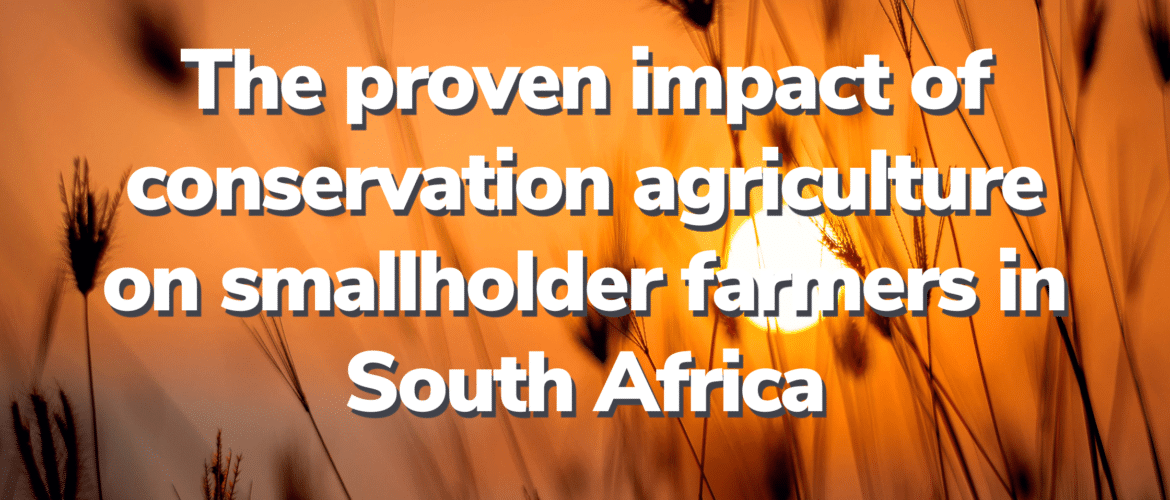
The Proven Impact of Conservation Agriculture on Smallholder Farmers in South Africa
In the vast agricultural landscapes of sub-Saharan Africa, smallholder farmers form the backbone of food production. Yet, they face a multitude of challenges exacerbated by climate change, including unpredictable weather patterns, soil degradation, and dwindling yields, leading to poorer yields and reduced income for farmers.
In the context of these very real challenges, conservation agriculture (CA) stands out as a potential solution. Unlike traditional farming methods that involve extensive tillage and soil disturbance, CA emphasises three core principles:
- Minimum mechanical soil disturbance
- Maintaining organic soil cover
- Diversifying crop species
By adhering to these principles, farmers can enhance soil health, increase productivity, and mitigate the impacts of climate change. Conservation agriculture is also 20-50% less labour-intensive than mainstream farming, making it more efficient and viable for small producers and helping them improve and sustain production and profitability.
Despite these benefits, the adoption of CA in South Africa has been relatively slow, compounded by several underlying factors, including a lack of awareness, knowledge and understanding of:
- Environmental problems
- The nature and function of natural resources (ecology)
- Appropriate solutions to address these issues
In South Africa, the prevailing crop production systems reliant on intensive and continuous soil tillage have resulted in alarmingly high rates of soil degradation, particularly in grain-producing regions. This degradation exacerbates existing challenges related to profitability and poverty in rural areas. To provide farmers with a better chance of sustaining their livelihoods and to achieve sustainable and economically viable agriculture, there is an urgent need to overhaul traditional paradigms of agricultural production and management.
Farmer-centred innovation through the CA FIP
In response to these pressing issues, initiatives like the Conservation Agriculture Farmer Innovation Programme (CA FIP) have emerged to empower farmers with sustainable solutions. The mission of the CA FIP is to guide, coordinate and facilitate research, development and adaptation of appropriate conservation agriculture systems for a range of diverse and unique situations in the whole grain production area of South Africa.
Since its inception in 2013, the CA FIP programme has diligently worked alongside local small-scale farmers and researchers to implement on-farm trials and disseminate crucial findings. Through collaborative efforts, the CA FIP has not only generated valuable data but has also fostered a culture of knowledge sharing and empowerment within farming communities.
- Addresses various CA research questions in trials.
- Compares and analyses different production systems.
- Selects, monitors and analyses a selection of indicators on soil health, biodiversity, production, efficiency and financial performance.
- Share the results via farmers’ days, conferences, articles, videos and social media.
Key results and impact of conservation agriculture
Through training programs, on-farm trials, and knowledge exchange initiatives, farmers have gained the necessary skills and resources to implement CA practices effectively. The Department of Agriculture, Land Reform and Rural Development’s report, ‘CLIMATE-SMART AGRICULTURE: Evidence-based Case Studies in South Africa’, features recent results achieved by the programme.
- A rapid impact assessment of the CA FIP was done in 2022, showing CA growth (adoption) of 8% per year due to the CA FIP influence.
- CA has emerged as a cost-effective and sustainable farming approach, offering smallholder farmers a pathway towards improved profitability and resilience.
- By reducing input costs and enhancing productivity, CA practices have bolstered the economic viability of farming operations, particularly in the face of climate variability.
- The adoption of CA practices has led to significant improvements in soil health, biodiversity, and ecosystem resilience.
Policy recommendations for promoting CA adoption
- Governments, NGOs, and agricultural organisations should prioritise investments in farmer-led research and participatory extension services. By supporting on-farm trials, knowledge exchange platforms, and capacity-building initiatives, policymakers can facilitate the widespread adoption of CA practices.
- Financial incentives, subsidies, and support schemes can incentivise farmers to adopt CA practices and invest in sustainable farming technologies.
- Integration of CA principles into agricultural policies, extension services, and land-use planning frameworks is essential for mainstreaming sustainable farming practices.
- Aligning policies with conservation objectives and climate resilience goals to create an enabling environment for CA adoption and implementation.
An ideal system for sustainable and climate-smart agricultural intensification
The proven impact of conservation agriculture on smallholder farmers cannot be overstated. CA helps smallholder farmers attain higher levels of productivity and profitability while improving soil health and the environment.
With initiatives like the CA FIP leading the charge, farmers are empowered to embrace resilient and sustainable farming practices. Through farmer-led innovation, partnership, and policy support, CA has the potential to transform agricultural landscapes, enhance food security, and promote environmental sustainability on a global scale.

About the Author: Alex Platt
Alex is Business Development Manager at RegenZ. He's inspired by the potential of regenerative farming and takes a special interest in the technology and products that are moving agriculture in a more sustainable direction.
